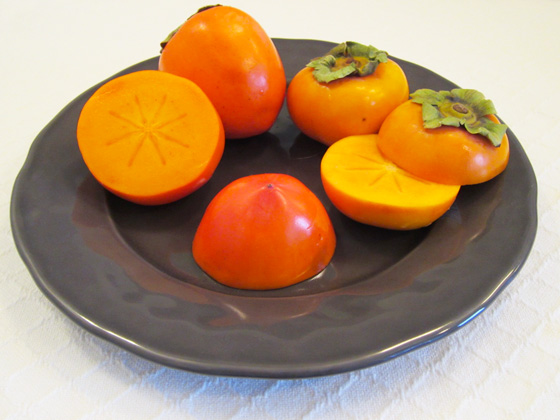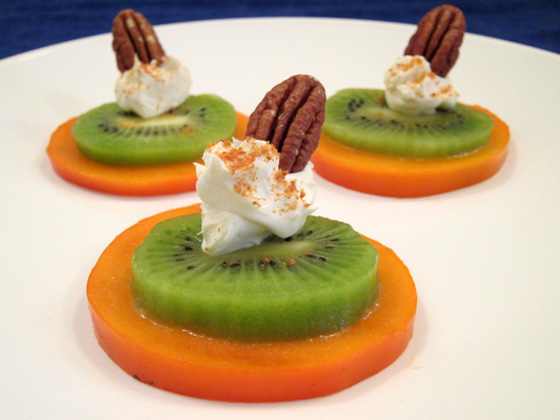
The two most popular varieties of Japanese persimmon:
'Hachiya' on the left, 'Fuyu' on the right
There are many harbingers of winter. Persimmon is one of the more reliable ones.
Living in North Berkeley during my halcyon days, I never took particular notice of the modest tree in my neighbor's front yard. Until one autumn, when the leaves turned a brilliant, fiery orange. I marveled at the intensity of the color, as you don't often see such brilliant fall shades in California.
But it was when that brilliant fire began to extinguish, the leaves falling to the ground like dying embers, that I saw an even more illuminating sight. Dangling throughout the canopy were orange effulgent orbs; persimmon fruit, to be exact, once cloaked by leaves of a similar hue, now naked and incandescent.
And that always seems to happen right about now, when the solstitial arrival of Old Man Winter is just a few short weeks away.
Persimmons are native to the United States, indigenous from about Keokuk, Iowa down to Houston, Texas, and east to the Atlantic. But that is the American Persimmon, also known here as the Common Persimmon, a different species of fruit than the ones we commonly see in the store (and on my neighbor's tree). Those persimmon are what we call Japanese Persimmon, which are native to -- you guessed it -- China! (Where it is believed to have been cultivated for over 2,000 years.)
Though there are many varieties of Japanese persimmon, you are likely only going to come across two, the 'Hachiya' and the 'Fuyu.'
It's important you know the difference between these two fruits, as one -- if eaten before fully ripe -- will likely make you swear off persimmon forever!
Both varieties of persimmon look like orange tomatoes. Hachiya is more oblong with a pointed end, akin to a plump roma. Fuyu is squat, with a flattened bottom, like smaller heirloom tomatoes. Both are vibrant orange, though Fuyu is yellower than Hachiya.
But here is where you really need to pay attention: Hachiya is known as an astringent persimmon. If you bite into an unripe Hachiya, you will be greeted with a flood of bitter tannin that will sheath your tongue in shrink wrap. Your palate will pucker. Your tongue will dry up. You will curse. And you will never look at a persimmon again. Never ever.
But if you let the persimmon ripen (just leave it on the counter, pointy end up, for a week or two), you will be rewarded with a rich, sweet fruit, moist and soft.
Fuyu, on the other hand, is a firm, non-astringent persimmon. You can eat Fuyus just like an apple. It won't be as sweet when not-quite-ripe (akin to an apple), but it won't have your tongue curling backwards into your throat, either.
Like many foodies, when creating simple dishes, I like to pair different foods that are at their peak of ripeness at the same time of the year. This is easy during the summer, because so much is available. But folks are often flummoxed during the winter months, especially when trying to create fresh fruit dishes.
That is why I like persimmon. Its bright color, creamy texture and sweet flavor work well with other, more tart winter fruits, like kiwifruit and citrus. (Here's a quick and delicious pairing of persimmon with finger lime.)
Or try this for a simple yet vibrant dessert sure to brighten the gray days of winter:
Persimmon-Kiwifruit Sunshine

INGREDIENTS
2 ripe Hachiya persimmon
2 ripe kiwifruit
16 rounded tsp mascarpone cheese
16 toasted pecans
Mace
(optional: maple syrup)
PREPARATION
Slice persimmon and kiwifruit crosswise into eight slices per fruit. (So you should have 16 slices of persimmon and 16 slices of kiwifruit. The skin on the kiwifruit can be left on if you like... it is thin and quite edible).
Lay a couple of pieces of sliced persimmon on a plate, then add sliced kiwifruit, then mascarpone, and top with a single toasted pecan. Using your fingers, carefully dust the mascarpone with mace. Not a lot, as a little goes a long way. OPTION: For added sweetness, drizzle a little maple syrup on the plate.
Serve with forks and watch as the pursed lips mouthing "oooh" evolve into happy grins.